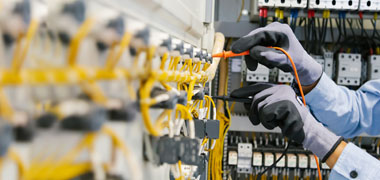
How do I become a rail traction linesman?
All skill levels
Beginner
Experienced
Recommended
UET30721
Certificate III in ESI - Rail Traction
On Campus, Traineeship
4 years
Unavailable
- There are no mandated entry requirements.


BSB50420
Diploma of Leadership and Management
Blended, On Campus, Online, Traineeship
12 - 24 months
$0 - $8,300
- There are no mandated entry requirements.
Office Manager
Team Leader
Supervisor
+ 267 more
Project Coordinator
Assistant Manager
General Manager
Area Manager
Presales Consultant
Regional Manager
Service Director
Team Administrator
Governance Coordinator
Creative Entrepreneur
ICT Project Manager
Data Miner
Product Specialist
Digital Project Manager
Corporate Services Manager
Account Manager
Senior Risk Manager
Park Manager
Information Officer
Customer Service Officer
Life Coach
Sports Facility Manager
Landfill Supervisor
Investigation Manager
RTO Compliance Officer
Intelligence Officer
National Security Adviser
Innovation Coordinator
Customer Success Manager
Chief Innovation Officer
Logistician
Innovation Manager
Event Planner
Strata Manager
Student Experience Officer
Travel Agency Manager
Regional Coordinator
Conservation Manager
Venue Manager
Real Estate Agency Manager
Bank Manager
Aquaculture Manager
Sustainable Farmer
Winemaker
Vineyard Manager
Planning Officer
Social Media Strategist
Cellar Door Manager
Resilience Officer
Head of Procurement
Head of Digital Strategy Transformation
Radio Producer
Accounting Manager
Financial Controller
Forensic Accountant
Customer Experience Manager
Innovation Strategist
Operations Officer
Customer Service Manager
Fraud Analyst
Financial Assistant
Assistant Broker
Library Assistant
Museum Assistant
Librarian
Gym Manager
Fitness Centre Manager
Sales Analyst
High Performance Coach
Event Director
Exhibition Manager
Tour Operations Manager
Local Government Customer Service Assistant
Reservations Manager
HVAC Technician
Council Member
Bakery Manager
Clinical Coder
Grip
Gaffer
Driller
Drilling Supervisor
Service Manager
Helicopter Pilot
Flying Instructor
Concreter
Parts Manager
Steel Fixer
Executive Housekeeper
Surveyor Assistant
Plant Manager
Fleet Manager
Duty Manager (Police Force)
Facilities Manager
Airport Operations Manager
Abattoir Supervisor
Technical Project Manager
Senior Merchandiser
Workplace Inspector
Rail Safety Manager
Crematorium Technician
Athlete
Community Coach
Renewable Energy Tradesperson
Funeral Director
Funeral Assistant
Electrical Fitter
Electrical Linesman
Rail Traction Linesman
Cable Jointer
Substation Technician
Driller Offsider
Geological Technician
Watchkeeper Deck Officer
Timber Dispatch Coordinator
Head of Cyber Security
Dog Trainer
Senior Rates Officer
Senior Compliance Officer
Environmental Health Officer
Cabin Crew Supervisor
Professional Dancer
Water Treatment Supervisor
Dam Operations Manager
Irrigation Water Supervisor
Water Networks Supervisor
Trade Waste Officer
Catchment Officer
Reporting Analyst
Chief Technology Officer (CTO)
Business Specialist
Sales Engineer
Business Development Executive
Business Services Manager
Procurement Manager
Retail Executive
Category Specialist
Procurement Consultant
Operations Specialist
Workforce Analyst
Facilities Coordinator
Grants Officer
Retention Specialist
Workshop Supervisor
Performance Manager
Scrum Master
Claims Specialist
Solutions Architect
Agile Business Analyst
Commercial Analyst
Technical Business Analyst
Technical Lead
Technical Consultant
Relationship Manager
Program Coordinator
Cost Controller
Travel Operator
Cluster Manager
Business Leader
Diversity Consultant
International Development Worker
Lobbyist
Policy Specialist
Chief Operating Officer (COO)
Crime Prevention Officer
Social Justice Advocate
Court Administrator
Investigator
Museum Director
Records Manager
Financial Regulator
Policy Researcher
Engagement Manager
International Project Manager
Film Producer
Location Manager
Arts Programmer
Recruitment Manager
Strategy Consultant
Human Rights Advocate
Editorial Writer
Creative Writer
Climate Scientist
Partnerships Manager
Resource Economist
Agricultural Economist
Neurologist
Meteorologist
IT Specialist
Strategic Advisor
Transport Manager
Geochemist
Palaeontologist
Photogrammetrist
Nutrition Advisor
Nutrition Scientist
Commercial Manager
Executive Director
Mining Manager
Primary Health Organisation Manager
Health Administrator
Healthcare Manager
Global Account Manager
Customer Relationship Manager
Program Leader
Capability Manager
Public Administrator
Training and Development Manager
Technical Manager
International Business Strategist
Service Delivery Manager
Organisational Development Consultant
Operations Analyst
Strategy Manager
Business Process Analyst
Project Director
Hospital Administrator
Clinical Manager
Pharmacy Manager
Health Manager
Political Consultant
Community Engagement Coordinator
Policy Writer
Wellness Coordinator
Risk Consultant
Development Manager
Theatre Manager
Clinical Supervisor
Early Childhood Center Manager
Superintendent
Performance Coach
Continuous Improvement Manager
Police Sergeant
Sheriff
Aviation Consultant
Religious Education Coordinator
Sports Marketing Manager
Category Manager
Contract Specialist
Wellbeing Coordinator
Social Work Supervisor
Media Relations Specialist
Nurse Manager
Talent Acquisition Manager
Quality Control Manager
Vendor Manager
Site Manager
Athletic Director
Program Evaluator
Food Service Supervisor
Research and Development Manager
Finance Director
Acquisition Manager
Executive Manager
Leadership Coach
IT Operations Manager
Advertising Account Manager
Economics Consultant
Education Coordinator
Senior Project Manager
Chief Project Officer
Promotions Manager
Hospitality Manager
People and Culture Manager
Employee Relations Manager
Company Director
Business Relationship Manager







CPC40120
Certificate IV in Building and Construction (Building)
Blended, On Campus, Online
11 - 18 months
$0 - $9,500
- There are no mandated entry requirements.
Building Estimator
Construction Supervisor
Site Foreman
+ 20 more
Construction Project Manager
Construction Estimator
Building Supervisor
Building Contractor
Wind Turbine Engineer
Field Engineer
Electrical Linesman
Rail Traction Linesman
Cable Jointer
Substation Technician
Blocklayer
Apprentice Scaffolder
Engineering Surveyor
Architectural Designer
Sprinkler Fitter
General Hand
Building Inspector
Construction Consultant
Civil Construction Supervisor
Site Manager





CPC50220
Diploma of Building and Construction (Building)
Blended, On Campus, Online
12 - 24 months
$0 - $19,150
- There are no mandated entry requirements.
Building Estimator
Construction Supervisor
Site Foreman
+ 40 more
Construction Manager
Construction Project Manager
Construction Estimator
Building Contractor
Building Supervisor
Wind Turbine Engineer
Rigger
Bricklayer
Infrastructure Engineer
Structural Project Manager
Scaffolder
Mobile Crane Operator
Renewable Energy Tradesperson
Electrical Fitter
Electrical Linesman
Rail Traction Linesman
Carpenter
Cable Jointer
Substation Technician
Construction Worker (Water Infrastructure)
Dam Operations Manager
Irrigation Water Supervisor
Water Networks Supervisor
Catchment Officer
Building Manager
Engineering Surveyor
Construction Worker
Roof Tiler
Shopfitter
Asbestos Supervisor
Architectural Designer
Architectural Engineer
Sprinkler Fitter
General Hand
Building Inspector
BIM Manager
Construction Consultant
Civil Construction Supervisor
Building Consultant
Construction Site Manager




Related occupations
Common questions
Further reading


Most popular manufacturing courses
19th July 2022)

